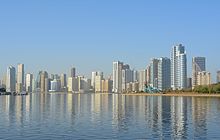Real estate market in Sharjah

The real estate market in Sharjah refers to the construction and commodity market in the UAE's third largest emirate, Sharjah. The market has undergone significant transformation over the past few decades, buoyed by economic growth, legislative changes, and a burgeoning population.
History[edit]
Early Beginnings (pre-20th century)[edit]
Historically, Sharjah's real estate market was predominantly local, characterized by traditional houses and limited commercial structures.[1] At the time, Sharjah had a sparse population with communities primarily settling around oases, coastal areas, and inland trading routes.[1][2] The architecture during the period was tailored to the desert environment, resulting in traditional Arabian houses made of palm fronds, mud bricks, and coral stones. These structures, also known as "barasti" or "arish" houses, were designed for natural ventilation, offering shelter from the summer heat.[1][3]
The pearling era (early to mid-20th century)[edit]
In the first half of the 20th century, the pearling industry was a significant contributor to the economy of the Trucial States (present-day UAE). Sharjah's coastal location made it an essential hub for pearling, leading to the development of coastal residential clusters and marketplaces known as "souqs".[4] While the pearling boom led to economic growth, the global economic depression of the 1930s, combined with the invention of cultured pearls in Japan, marked the decline of the pearling industry.[5][6]
Emergence of Modern Infrastructure (1960s)[edit]
With the discovery of oil in the region in the 1960s, Sharjah, like its neighboring emirates, witnessed significant infrastructural investments. Though not as resource-rich as Abu Dhabi or Dubai, Sharjah benefited from the overall growth of the region. This era marked the beginning of more modern architectural designs with the construction of concrete buildings, replacing many of the traditional structures.[7][8]
Urbanization and Expansion (1970s-1990s)[edit]
The oil boom in the UAE in the late 20th century brought increased wealth and led to modernization.[9] Post-independence in 1971, Sharjah embarked on rapid urbanization. The oil revenues, though lesser compared to other emirates, were strategically invested in infrastructure, education, and cultural initiatives. The city saw the rise of multi-storey residential and commercial buildings.[9][10]
Diversification and growth (late 20th to early 21st Century)[edit]
From the late 20th century onwards, the government of Sharjah actively sought to diversify its economy.[11] The establishment of the Sharjah Airport International Free Zone in 1995 attracted numerous businesses, leading to an increased demand for commercial and residential spaces.[10] The early 2000s saw several large-scale real estate projects being initiated, reflecting the emirate's ambition to position itself as a key player in the UAE's real estate market.
See also[edit]
References[edit]
- ^ a b c Kay, Shirley (1992). Sharjah: Heritage and Progress. Motivate Publishing. ISBN 978-1873544334.
- ^ Mills, David (2019). History of United Arab Emirate. SONITTEC. ISBN 978-1912483846.
- ^ Shoup, John A. (2022). History of the United Arab Emirates. ABC Clio. ISBN 978-1-4408-7043-9.
- ^ Carter, Robert A. (2012). Sea of pearls: seven thousand years of the industry that shaped the Gulf. London: Arabian. ISBN 978-0-9571060-0-0.
- ^ United Arab Emirates University; Aqil, K. (2018). "PEARL INDUSTRY IN THE UAE REGION IN 1869-1938: ITS CONSTRUCTION, REPRODUCTION, AND DECLINE". RUDN Journal of Sociology. 18 (3): 452–469. doi:10.22363/2313-2272-2018-18-3-452-469.
- ^ Errichiello, Gennaro (2023), Rahman, Md Mizanur; Al-Azm, Amr (eds.), "The Transformation-Migration Nexus in the United Arab Emirates: A Historical Analysis", Social Change in the Gulf Region, vol. 8, Singapore: Springer Nature Singapore, pp. 189–205, doi:10.1007/978-981-19-7796-1_12, ISBN 978-981-19-7795-4, retrieved 2023-08-24
- ^ Trench, Richard, ed. (1994). Arab Gulf Cities. Chippenham: Archive Ed. ISBN 978-1-85207-540-8.
- ^ El Mallakh, Ragaei (2015). The economic development of the United Arab Emirates. Routledge library editions. The economy of the Middle East. London New York: Routledge, Taylor & Francis Group. ISBN 978-1-138-82015-9.
- ^ a b Al-Qassemi, Sultan Sooud; Reisz, Todd, eds. (2021). Building Sharjah. Basel: Birkhäuser. ISBN 978-3-0356-2276-8.
- ^ a b Guéraiche, William (2017). The UAE: geopolitics, modernity and tradition. International library of human geography. London New York: I.B. Tauris. ISBN 978-1-78453-930-6.
- ^ Siddiqui, Shamim Ahmad; Afzal, Munshi Naser Ibne (2022-07-26). "Sectoral diversification of UAE toward a knowledge-based economy". Review of Economics and Political Science. 7 (3): 177–193. doi:10.1108/REPS-07-2021-0075. ISSN 2356-9980.
